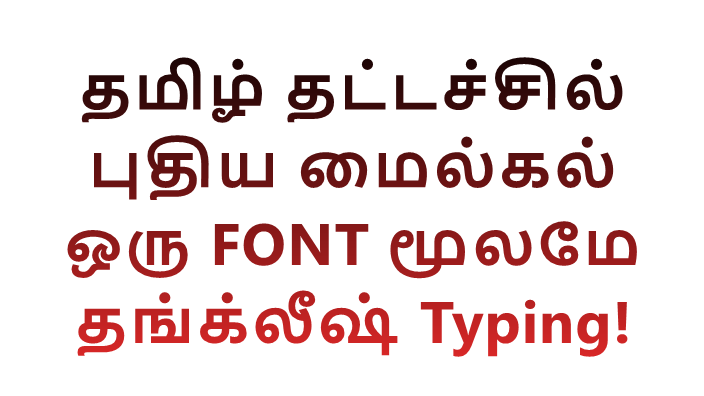looks_one
Uniqueness of Azhagi's Tamil Transliteration Scheme
VERY VERY IMPORTANT - to be aware of
The contents of this page are only a COPY of the pertinent text contents of what is present in http://web.archive.org/web/20180210172526/http://mazhalaigal.com/tamil/software/0806akr_azhagi.php#easiest-fastest. In other words, (late) Shri. A.K. Rajagopalan sir wrote the following in the aforesaid web page in 2 parts, many years ago. I have only just presented those 2 parts hereunder, in this one single page itself. I decided to do this since the aforesaid archived web page is slow to get loaded fully. I thought it will be always easier for the user when a web page loads as fast as possible. Well, I take this opportunity to thank a TON, the creators/maintainers of WebArchive, for saving the aforesaid writeup by (late) Shri A.K. Rajagopalan sir (who was the loving initiator of this Wikipedia article on Azhagi too - http://ta.wikipedia.org/s/87g)PART 1
Transliteration is the method by which letters of a required language can be displayed in a computer by typing out the letters of another language that are phonetically equivalent to the letters of the required language. Azhagi does the transliteration from English to Tamil. Tamil letters are displayed by typing out the phonetic equivalent English letters. The transliteration scheme of Azhagi is unique in the sense that the letters which are most natural for every sound are chosen as the phonetic equivalents as compared to other softwares."Azhagi - the Easiest and Fastest tamil transliterator - since 2000"
The forthcoming examples will make the viewer understand and appreciate the uniqueness of Azhagi in transliteration.
By seeing the explanation below, one can easily understand how Azhagi's transliteration scheme is the easiest and fastest, compared to any other software's. In this urgency-prone modern world, increase in productivity is always a welcome sign for any entity - whether its an individual or company. If a para typed in 10 mts using some other software can be typed in 5 mts itself using azhagi (considering it's easier, faster transliteration scheme), its only to the benefit of all that you spread the news of azhagi to one and all.
நீங்க
The tamil word "நீங்க" can be obtained by typing the english letters "neenga" as well as "niinga" in Azhagi whereas "niingga" is the only option available in some of the other softwares and you should type "weengga" in some other software. Note that the extra 'g' and the unnatural alphabet 'w' need not be typed in Azhagi.The letters 'ee' in English are used for any word where the sound 'ஈ' occurs. For e.g. 'keep', 'weep', 'seen' etc. There is no known word in English where 'ee' is used to give some other sound. Also, there is no known word in English where 'ii' is used in a word to give 'ஈ' sound. Even if it is used, it could only be a rarity.
மஞ்சு
You get மஞ்சு by typing "manju" which is the most natural phonetic combination in Azhagi unlike certain other softwares in which you have to type "manjchu" or 'manjsu' which are very unnatural and complicated. Note that the effort of typing two alphabets "ch" can be saved when using Azhagi.பொய்
"பொய்" is obtained by typing "poi" as well as "poy" in Azhagi whereas "poy" is the only option in certain others. Typing "poi" is more natural, straight forward and intuitive.கேட்டு
Azhagi gives "கேட்டு" by typing "kaettu" which is the most natural phonetic combination. In other software you have to type the unnatural combination "keettu" or "kEttu" taking pains to press the shift key. The letters 'ee' in English are used for any word where the sound 'ஈ' occurs. For e.g. 'keep', 'weep', 'seen' etc. There is no known word in English where 'ee' is used to give some other sound. Even if it is used, it could only be a rarity.நமஸ்காரம்
Typing "namaskaaram" straightaway gives "நமஸ்காரம்" without having to type as "namaSkaram" in other software where the shift key is to be pressed to type capital "S". Azhagi does the transliteration correctly even with capital "S".கூடம்
Typing "koodam" and "kuudam" both give "கூடம்" in Azhagi whereas "kuudam" is the only option in other software. The lettes "oo" are the most natural ones to get the sound "ஊ" for eg., cool, tool, boolean etc. Azhagi has taken this into consideration and has made transliteration a pleasure.நன்றி
The word "நன்றி" is obtained in Azhagi only by typing "nandri" without having to type "nanRi" with capital "R" which needs the operation of the shift key. "nanRi" also works correctly in Azhagi.ஸ்ரீனி
"ஸ்ரீனி" can be obtained by typing any one among "srini", "shrini", "Srini", "Shrini" without and with the shift key operation.கோவில், கோயில்
The word "கோவில்" and "கோயில்" is obtained in Azhagi by typing "koavil" and "koayil" with "oa" for the sound "ஓ" most natural in English, for e.g., coat, coal etc. You have to type "koovil" or "koovil" and "kOvil" or "koovil" that are quite unnatural and involve the need to press the shift key in other softwares.There is much more to come and will be covered in later chapters.
PART 2
"Azhagi" refers to a beautiful girl or woman in Tamil language. The sage "Vatsyaya" in his famous book "kamasutra" has explained the factors and qualities to be taken into consideration to distinguish and compare the beauty of women. These not only include the physical conditions but also the mental status and intellectual of women that account for their social behaviour and other virtues.
Likewise Vishy, the creator of "Azhagi" has made the software so beautiful by taking sufficient care to make the transliteration features of the software the most versatile among all other such softwares with as many alternative keystrokes as possible to enable the user create and edit tamil contents with ease.
The transliteration for the twelve vowels of Tamil namely அ, ஆ, இ, ஈ, உ, ஊ, எ, ஏ, ஐ, ஒ, ஓ, ஔ is configured by suitably combining the five vowels of English namely a, e, i, o, u giving due consideration to the most natural combinations for the sound corresponding to each vowel.
"a" gives "அ";
As many alternatives as possible are given for consonants of Tamil as well as grantham (க்ரந்தம்).
"c", "k", "kh", "g" and "gh" give "க்";
Words like "அங்ஙனம்", "அங்கே", "இங்ஙனம்", "இங்கு" etc. are created by typing "anGnGanam", "angae", "inGnGanam", "ingu" etc. easily. The words such as "விஸ்வம்", "பஸ்மாசுரன்", "பஸ்பம்" can be directly typed as "visvam" or "viswam", "basmaasuran", "baspam" or "basbam" without having to type "S" for "ஸ்". The words like "லக்ஷ்மி", "பக்ஷம்", "மோக்ஷம்" can be obtained by directly typing "lakshmi", "paksham" and "moaksham". "விஞ்ஞானம்" can be obtained by typing "viGnGnaanam". The words like "மஞ்சம்", "நெஞ்சம்", "கொஞ்சம்" can be directly typed as "manjam", "nenjam", "konjam".
The words line "கண்டம்", "துண்டு", "இரண்டு" can be directly typed as "kandam", "thundu", "irandu" without having to type "N". The words like "மெய்", "பொய்" can be obtained by typing "mei" or "mey" and "poi" or "poy". The words like "தென்றல்", "மன்றம்", "என்று" can be directly typed as "thendral", "mandram", "endru" without having to type "R". The words like "பற்று", "கற்றவர்", "மற்றவர்", "கொற்றவன்" can be directly typed as "patru", "katravar", "matravar", "kotravan" without having to type "R" at all.
You get "சொந்தம்", "பந்தம்", "சுந்தரம்" by directly typing "sontham" or "sondham", "bantham" or "bandham" and "suntharam" or "sundharam". you can get "என்தன்" by typing "enThan".
There is much more to come and will be covered in later chapters.
AKR
"aa" and "A" give "ஆ";
"i" gives "இ"
"ii", "I" and "ee" give "ஈ";
"u" gives "உ";
"uu", "U" and "oo" give "ஊ";
"e" gives "எ";
"ae" and "E" give "ஏ";
"ai" gives "ஐ";
"o" gives "ஒ";
"oa" and "O" give "ஓ";
"au", "ou" and "ow" give "ஔ".
"nG" gives "ங்" and "ng" gives "ங்க்";
"s" and "ch" give "ச்";
"S" gives "ஸ்"; "sh" gives "ஷ்"; "ksh" gives "க்ஷ்";
"sri" and "Mr" gives "ஸ்ரீ";
"nj" and "Gn" give "ஞ்";
"t" and "d" give "ட்";
"N" gives "ண்";
"th" and "dh" give "த்";
"n" gives "ந்" and "ன்" depending on the position of the letter in the word while "nh" gives "ந்" anywhere.
"p", "b" and "bh" give "ப்" while "ph" gives "ஃப்";
"m" gives "ம்";
"y" gives "ய்";
"r" gives "ர்";
"v" gives "வ்";
"z" and "zh" give "ழ்";
"L" gives "ள்";
"R" gives "ற்";
"h" gives "ஹ்";
 To be continued....
To be continued....
NOTE: Pertinent contents for 'Part 2' above were extracted from http://web.archive.org/web/20180220094256/http://www.mazhalaigal.com/tamil/software/0808akr_azhagi.php











































































































































